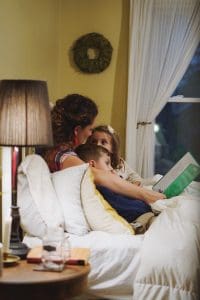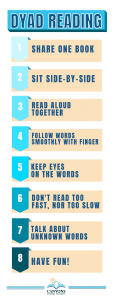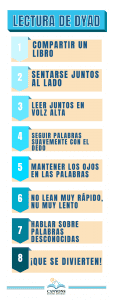CSD Reading Corner - Reading at Home
 Learning to read is a joint effort between families and teachers. Adults can reinforce learning to read and build comprehension at home through structured practices such as:
Learning to read is a joint effort between families and teachers. Adults can reinforce learning to read and build comprehension at home through structured practices such as:
Dyad Reading
Dyad reading is a research based reading strategy where two students (or a student and a parent) share one text, sit side-by-side and read together. To learn how to use Dyad reading at home, watch the following video and download the attached resource.
Daily Reading
Daily Reading– Read with your student every day for 20-30 minutes. Adults can read to their students, students can read to adults and students can read independently. Guide students through their reading by asking comprehension questions, for example, tell me the names of the characters in the story, or share with me how the text ended. Use your finger to track under each word when reading with your child.
- Make reading part of the home daily routine:
- First thing in the morning
- After lunch
- Before dinner
- Before bedtime
- Make reading part of the home daily routine:
Read Aloud Strategies listed in the order of most supportive to independence.
- Cloze Read: Oral cloze reading involves the teacher (or parent) reading aloud and choosing specific words to not say, while students actively track the text and read the words aloud omitted by the teacher (or parent). Choose nouns or key vocabulary words to omit.
- Echo Reading: Echo reading is when the teacher (or parent) reads a phrase/sentence/paragraph/section of a text aloud and students repeat what the teacher (or parent) read with the same expression and attention to punctuation.
- Choral Reading: Choral reading is when the entire group reads a text aloud together at the same time.
- Partner Reading: Partner reading is when two students (or a student and a parent) are reading the same text, but take turns reading the passage.
- Whisper Reading: Whisper reading is when all students in the class (or at home) are reading a passage and each student is whisper reading the passage at their own pace.
- Retell the Text:
Narrative | Informational |
|
|
There are a variety of text resources available for use at home to support students in developing their reading skills. Below are websites with varied text, including decodable texts available to print for practice. “Decodable text is a type of text used in beginning reading instruction. Decodable texts are carefully sequenced to progressively incorporate words that are consistent with the letter–sound relationships that have been taught to the new reader.” (The Reading League, 2020). We encourage parents and caregivers to use routines such as the Story Share Routine and the Decodable Reader Routine to make the best use of this time with text. Decodable text should be used in addition to high interest texts that students have some choice over.



